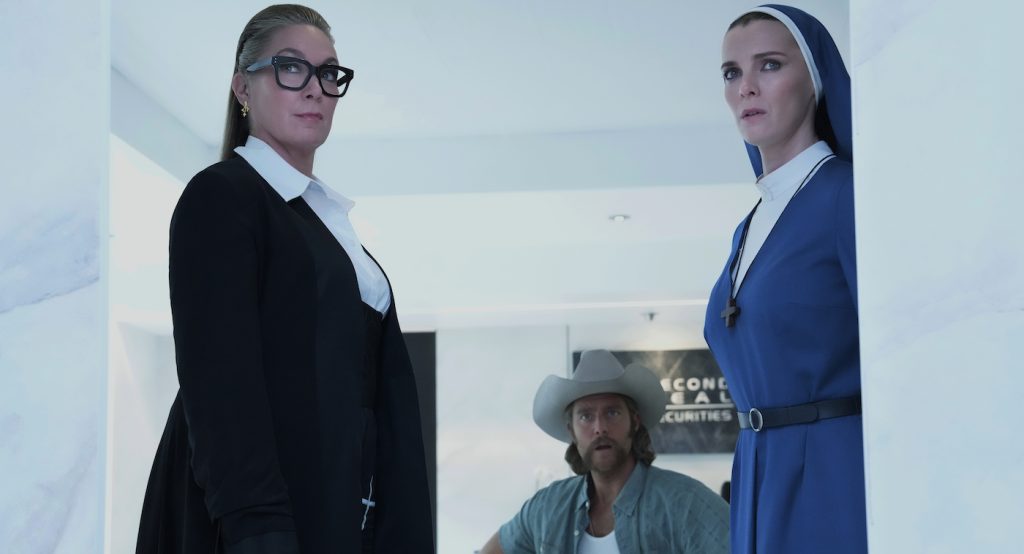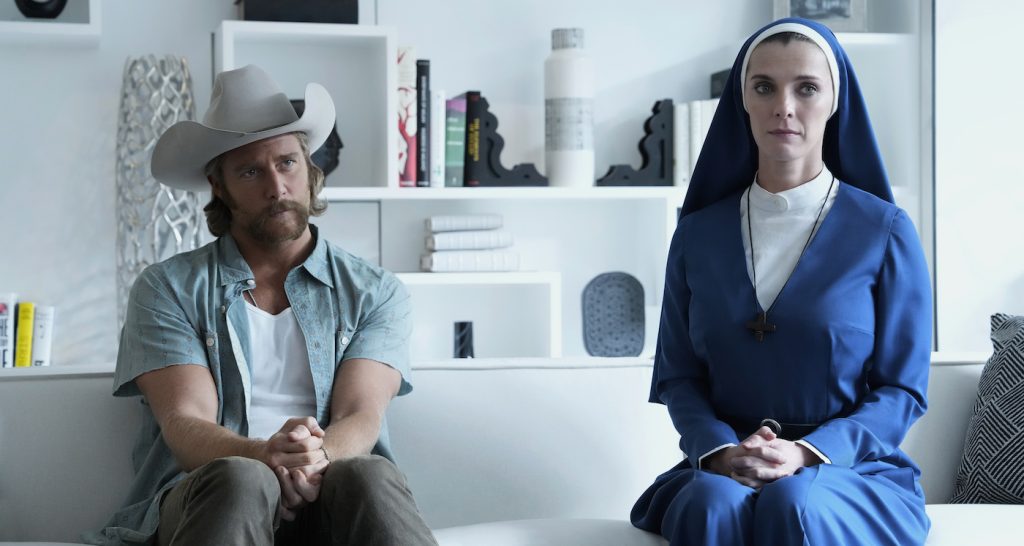“Mrs. Davis” Director Owen Harris on Pitting a Nun vs. Artificial Intelligence in Peacock’s Potent New Series
A marauding nun married to Jesus takes on an omniscient artificial intelligence in Mrs. Davis, Peacock’s irreverent new thriller set across the globe. Simone (Betty Gilpin) makes a deal with Mrs. Davis, the ubiquitous AI, wherein should she succeed in a quest to find and destroy the Holy Grail, Mrs. Davis, whom Simone believes killed her father, will self-destruct. After linking back up with her wealthy failed rodeo rider ex-boyfriend Wiley (Jake McDorman), the pair set off on a globetrotting journey that’s as much about our complex relationships to technology, faith, and family as it is a madcap caper.
Owen Harris, who directed “San Junipero,” a critical and fan-favorite Black Mirror episode, directed this series’ pilot, finale, and episodes two and five. “My episodes were part of this bigger whole we were trying to create, but every single episode was like a pilot,” Owen says. “Each one does something in some crazy way, and it’s big and ambitious and tonally ingests another genre.” By way of example, Owens points out that the series opens with a seemingly free-floating, over-the-top medieval bloodbath and adds a new main character halfway through the season. “I think we ask a lot of our audience in Mrs. Davis, but I feel that we repay their investment in us.”
Punctuated by Simone’s visits to her husband Jay/Jesus (Andy McQueen), Simone and Wiley’s quest levels up thanks to a mysterious man on a desert island, an even odder cabal of women in business suits, and Simone’s mom, Celeste (Elizabeth Marvel). Through it all, Mrs. Davis persists, speaking to the nun doing her bidding via a docile public willing to act as the AI’s literal mouthpiece. We spoke with Harris about the show’s surprisingly retro references, making a theme as outlandish as exploding heads ring true, and the real-world AI that coincidentally came on the scene on the heels of the debut of Mrs. Davis.
What kind of references, if any, did you look to when making the show?
We wanted Simone’s convent to have a particular character and unique twist to it, which was the fact that these were Reno nuns. We built this whole atmosphere that she was going to live within. It was also fun to echo the famous dramatization of that, which was, for all of us, The Sound of Music. And also, there’s a joy to that tonality of being a nun, which we wanted to reflect — when she was in this world, it was a very safe, happy existence that gave her security. The shot where she goes running down the hill in Episode 4 is that moment. But for all of us, it was a show that allowed us to draw on cinematic references that we felt fit within this world. Betty Gilpin coined the phrase “no country for old Looney Tunes,” which sums up one ingredient, which was a mix of this Coen brothers feeling with something sillier and more wacky.

Looney Tunes is a great reference.
I had Looney Tunes plastered all over the office when I was making it. All those lovely pastels and washed-out colors. We would have liked to have pushed it more, but you’re always using these things as a reference. For us, it was about trying to pull that back down into reality so the more extreme elements of your reference aren’t pulling you into something that feels too cartoonish or takes away from the emotional side of the story.
Speaking of balancing extreme elements with reality, how did you approach the different exploding heads?
The whole show is playful in terms of its storytelling. There’s always a sense of play underlying the fake ones, just as there’s also a sense of play underlying the real, emotional ones. I think it’s that tonality that leads to a really interesting reaction to heads exploding or being decapitated, all of which is quite ghoulish, but in this show, the way you manage to pull it off is to land a certain energy or note. Certainly, in the pilot, the decapitation in the car, as they go under the billboard, is meant to ratchet up the absurdity. I think the moment you see this decapitated corpse; you’re already thinking, now you’re really playing with me. Then the fun of that moment is the fact that within that scene, we solve it. But you’ve set it up that in this show, not everything is going to be as it seems and to expect the unexpected.

The show hinges on a lot of religious elements without being religious at all. How did you manage that?
I don’t think for either [creators] Tara [Hernandez] or Damon [Lindelof], it was ever to create an attack or particular commentary on faith or religion or technology, for that matter. These were very important parts of everyone’s lives in one shape or form, so why can’t you tell a story about a nun’s faith and what it means to have that sort of unshakeable faith? On the flip side of that, you have people putting an enormous amount of unshakeable faith into technology. It was just a way of looking at the human condition and how we interact with these things. A lot of us are putting all our faith into technology, but maybe we’re starting to realize that that leaves us a little bit cold. And maybe that faith we turned our back on, maybe we need a little bit of that in our lives. When this was written during the pandemic, I think it brought out feelings in everyone about what it is that we’ve been investing a lot of our time and effort and attention and focus and faith in, and how happy are we with the status quo at the moment? The show lets us open up these points of the human condition and then polarizes it by picking a nun and picking this piece of AI to be at odds with each other and takes you on this ride.
It must be wild having worked on this, and then ChatGPT and Midjourney are released.
The timing is pretty incredible, I think. Again, it just illustrates where we are on the journey in terms of AI. I’ve certainly played around on both ChatGPT and Midjourney and been both impressed but also, like many of us, slightly concerned because we don’t know where this goes and, certainly, in a creative industry, what that could mean. And on the one hand, it’s quite exciting because I think it could accelerate ways of communication, breaking ideas, and looking at things, which I think could be useful, but at the same time, I think we’re so used to creativity, in particular, having a large human component, and the idea of reducing that further and further, is something we should be conscious of and concerned about, in terms of how it affects people’s livelihoods but also how we express ourselves. Mrs. Davis is something that has fun playing in this playground asking these questions, but ChatGPT and Midjourney are in the real world and are affecting people’s lives. We shouldn’t blindly accept what’s put in front of us. We should think about what we do with our time, what we put into these things, and what we get back out of them. I’m not terrified about it, and I will probably embrace it the way we’ve embraced every other piece of technology, but I think we should be a lot more conscious about our choices than maybe we have been.
Mrs. Davis is currently streaming on Peacock.
For more on Universal Pictures, Peacock, and Focus Features projects, check out these stories:
“Fast X” Stunt Coordinator Andy Gill on [Safely] Going Pedal to the Metal
“Five Nights At Freddy’s” Teaser Reveals Universal’s Horror Video Game Adaptation
New “Fast X” Video Reveals Battle Royale Between Letty & Cipher
Featured image: MRS. DAVIS — “TBD” Episode 104 — Pictured: Betty Gilpin as Simone — (Photo by: Sophie Kohler/PEACOCK)



